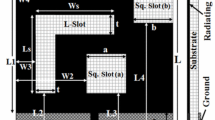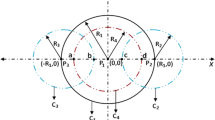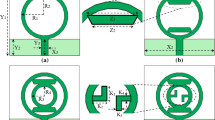Abstract
A 0.22λ×0.29λ×0.03λ miniaturized modified circular patch monopole antenna on high permittivity ceramic-Polytetrafluoroethylene (PTFE) composite material substrate is presented. The proposed antenna is designed and investigated using 3D full wave high frequency electromagnetic simulator and fabricated using printed circuit board (PCB) prototyping machine. Impedance bandwidths (Reflection coefficient <−10 dB) of 26.76 % (5.0–6.3 GHz), 5.3 % (9.1–9.6 GHz) and 3.6 % (10.7–11 GHz) have measured. Average gains of 0.9 dBi, 3.68 dBi and 3.63 dBi measured at first, second and third band correspondingly. 87.3 %, 88.5 % and 93.1 % radiation efficiencies have achieved at three resonant frequencies 5.6 GHz, 9.5 GHz and 10.9 GHz respectively. The measured symmetric and nearly consistent radiation pattern makes the proposed antenna suitable for C band and X band applications. In this letter, the effects of dielectric properties of substrate material and design parameters have studied.
Similar content being viewed by others
Avoid common mistakes on your manuscript.
1 Introduction
Antenna is one of the most significant elements of modern wireless devices. Owing to the recent advancement of wireless technology, a substantial amount of research attention has been given for antenna development. In order to integrate with the smart multifunctional wireless module antennas are necessary to be have multiband capabilities with compact size. As a result, antenna miniaturization becomes an interesting topic for antenna researchers. Antenna miniaturization has been an interesting research topic for last decades [1]. The basic approach of miniaturization of antenna element was addressed by Chu in 1948 [2] and Harrington in 1960 [3]. So far, antenna miniaturization and it’s limitations was addressed by Chu in 1948 [2]. Several techniques have been studied for antenna miniaturization, such as using artificial magnetic conductor [4], electromagnetic band gap (EBG) structure [5], reactive impedance surface (RIS) [6], metamaterial [7], multilayer substrate [8], stacked patch [9] and fractal shape [10] etc. Conventionally, miniaturized antennas suffer from narrow bandwidth, low gain and efficiency [3]. As a result, antenna miniaturization with multiband capabilities, wider bandwidth, higher gain and efficiency has become necessary to be integrated with modern microwave circuitry.
The polytetrafluroethylene was a lucky accidental invention by Rr. Roy Plunkett in 1938 [11]. Polymerized materials for microwave antennas were extensively investigated in 2005 [12]. The dielectric characteristics of ceramic-polymerized tetrafluroethelene (nF2C=CF2→{F2C–CF2}) allows for high frequency modulation with the influence of an electric field bias operating perpendicular to the signal propagation direction [16]. Consequently this property of the ceramic-PTFE provides a significant advantage to develop high frequency microwave and millimeter range devices. Recently developed ceramic-polymerized composite materials have low loss and high dielectric properties permit us to use for antenna miniaturization. The high dielectric constant can be obtain and characterized form ceramic mixture, therefore it reduces the size of the radiating patch significantly.
Modified circular patch monopole antenna on high permittivity dielectric material substrate is a promising candidate for compactness with better performance. Many researchers have been studied and investigated the split ring resonator (SRR) antennas and EBG structures [13–15]. However, the reported antennas are either large in size or narrow bandwidth, low gain and efficiency.
In this paper, we present a planar compact modified circular patch antenna on high dielectric ceramic filled polymerized tetrafluroethelene (PTFE) composite material substrate for C band WLAN and X band satellite applications. The measurement results of the proposed antenna exhibits impedance bandwidth of 1.5 GHz, 500 MHz and 300 MHz ranges from 5 GHz to 6.5 GHz, from 9.1 GHz to 9.6 GHz and from 10.7 GHz to 11 GHz respectively. It also achieved 0.9 dBi, 3.68 dBi and 3.63 dBi average gains have measured at first, second and third band respectively. 87.3 %, 88.5 % and 93.1 % simulated radiation efficiencies have observed at three resonant frequencies 5.6 GHz, 9.5 GHz and 10.9 GHz correspondingly. The radiation patterns at three resonant frequencies are also measured. The surface current distribution and the effect of dielectric properties of substrate material are analyzed. The proposed antenna is suitable for upper WLAN and WiMax applications. Furthermore, the proposed antenna is also suitable for X band short range portable micro radar applications such as, automotive detection and tracking, short range surveillance system, weather monitoring and forecasting, Doppler radar system etc.
2 Antenna design and configuration
There are two methods widely used to design microstrip patch antennas such as, Finite Difference Time Domain (FDTD) based CST, Method of Moment (MoM) based IE3D and Finite element method (FEM) based HFSS. The proposed antenna has been designed and analyzed using FEM based full wave high frequency electromagnetic simulator HFSS v.13. The proposed antenna has designed with compact dimension of 12×16 mm2 on 1.9 mm thick ceramic-polymerized tetrafluroethylene composite material substrate. The main objectives of designing proposed antenna is to be apposite for C band WLAN/WiMax, X band short range radar application with compact dimension. There is a tradeoff between antenna size and performances particularly gain. However, the proposed miniaturized antenna achieved satisfactory bandwidth and gain to be suitable for above mentioned applications. To achieve the desired resonance frequencies the radiating patch is configured accordingly. The diameter of the plane circle and position of the feedline determines the first resonance. The circular slot at the centre and the attached rectangular slot are responsible for the second and third resonances. The relative permittivity of polytetrafluroethylene alone is 2.1. By ceramic composition with polytetrafluroethylene the relative permittivity increased to 10.2. The dielectric loss tangent of the ceramic-PTFE substrate material is 0.002. Adjusting the composition ratio the permittivity of the material can be modified. Due to the low water absorption and thermal sensitivity, ceramic filled polymerized tetrafluroethylene is suitable for external use. The design procedure starts with the determination of the size of radiating circle and the inner circular and rectangular slot. The basic concept of the patch size was taken from the widely used mathematical formulation for patch antenna design [17]. However, the available mathematical equations are based on rectangular patch antenna. For modified circular patch antenna the size of the circle and slotted part are optimized using HFSS optimetrics.
The antenna design geometry and configurations has shown in Fig. 1. The ring width optimized to 4.5 mm with 2.5 mm long rectangular slot. A 5 mm long 2 mm wide microstrip line has used to connect the radiating patch and ground plane at the bottom that fed by a standard 50 Ω coaxial probe at the center of the X-axis along the Y-axis. Generally, high permittivity material based patch antenna suffers from narrow bandwidth [18]. To overcome this limitation, the bandwidth of the proposed antenna is improved by reducing the ground plane length. Reduction of ground plane length to a certain value effect the electromagnetic coupling between the radiating patch and the ground plane resulting in better impedance matching and improvement of bandwidth. Figure 2 shows the effect of ground plane length on reflection coefficient of the proposed antenna. It can be clearly seen that, 5 mm long ground plane provides the wider bandwidth compared to 10 mm and 16 mm (substrate size). The proposed antenna with 5 mm groundplane exhibits 33.93 % and 34.32 % of fractional bandwidth at lower and upper band respectively. The fractional bandwidths of 20.18 % and 15.08 % observed from 10 mm and 16 mm long ground plane at lower band However, bandwidth at upper band breakdown in to 15.63 %, 6.63 % from 10 mm and 6.41 %, 9.35 % from 16 mm ground plane have perceived. Although, the proposed antenna with 10 mm and 16 mm exhibits lower reflection coefficient value but bandwidth is narrower. The effect of dielectric property of three substrate materials on reflection coefficient has examined for the proposed antenna and shown in Fig. 3. For the analysis of the substrate material effect on reflection coefficient standard 50 Ω impedance matching has maintained using wave port exciation in simulator for the microstrip feed line. It has been observed that, antenna with low permittivity material substrate provides wider bandwidth but the resonance is shifted to higher frequency that is out of desired band and higher reflection coefficient value. Besides, the ceramic filled bio plastic material based antenna obtains lower reflection coefficient value but it provides narrower bandwidth compared to proposed ceramic-PTFE based antenna. The overall size of the proposed antenna on 1.9 mm thick ceramic-PTFE material (ε r =10.2) substrate is 60 % reduced compared to conventional FR4 based antenna.
3 Performance results
The proposed antenna has been fabricated on double sided copper imprinted ceramic-PTFE board using LPKF printed circuit board (PCB) prototyping machine. Figure 4 shows the photograph of the fabricated prototype of the proposed antenna. The performance fabricated prototype of the proposed antenna measured in a standard 5.5 m×4.5 m and 3.5 m height far-field anechoic measurement chamber. A double ridge guide horn antenna from AH systems inc. was used as a reference antenna (Model no.: SAS-571). A photograph of the anechoic measurement chamber is shown in Fig. 5. Pyramidal shaped electrically thick foam absorbers with less than −60 dB reflectivity at normal incidence was used on the walls, ceiling and floor. A turntable of 1.2 m diameter was used to rotate the measuring antenna with specifications of a 1 rpm rotation speed; 360° rotation angle and connected with a 10 m cable between controllers. A vector network analyzer (VNA) (Model No: Agilent E8362C) with a range of up to 20 GHz was used for the measurements.
Simulated and measured reflection coefficient of the proposed antenna has shown in Fig. 6. There is a good agreement observed between simulation and measurement result. The measured reflection coefficient vs. frequency graph shows that 1.5 GHz range from 5.0 GHz to 6.5 GHz, 500 MHz range from 9.1 GHz to 9.6 GHz and 300 MHz range from 10.7 GHz to 11 GHz achieved respectively. However, there is a slight inconsistency occurred between simulation and measured reflection coefficient result like bandwidth degradation, which can be due to SMA soldering effect or losses from cable and connector between antenna and controller. Even though, the complete setup was calibrated before measurement using Agilent auto calibration kit
The simulated and measured gain of the proposed antenna has shown in Fig. 7. It can be clearly observed that the average measured gains of 0.9 dBi, 3.68 dBi and 3.63 dBi achieved at first, second and third band correspondingly. Gains of the proposed antenna have measured by using three antenna measurement system with two identical horn antennas. One of the most important parameters for antenna designed is radiation efficiency. Figure 8 shows the simulated radiation efficiencies of the proposed antenna. 87.3 %, 88.5 % and 93.1 % radiation efficiency has been observed from the proposed antenna at three bands subsequently. Radiation efficiencies of the proposed antenna at three resonant frequencies are more than 80 %, which means more than 80 % of the signal can be transmitted. Therefore, minimum power is required for data transmission. The measured E and H plane radiation patterns of the proposed antenna at three resonant frequencies have shown in Fig. 9. From the radiation pattern it can be easily seen that, the cross polarization effect of the proposed antenna is lower than co polarization at all resonant frequencies. The simulated surface current distribution of the proposed antenna at three resonant frequencies has shown in Fig. 10. It can be observed that, the intensity of the distributed current is stronger in upper band compared to lower band. At the lower band the strongest current flows right side near feed line lower part of the ring whereas at the upper band the highest density of current flows in feed line and upper side and the near rectangular slot of the circle. A comparison between the proposed and some existing similar type of antennas are tabulated in Table 1. From the comparison it can be evidently observed that the proposed antenna performs better with smaller dimension than other reported antennas in terms of bandwidth and gain. Although, some of the antenna offers higher gain or wider bandwidth, but compromising the overall size.
4 Conclusion
A miniature modified circular patch monopole antenna on high permittivity ceramic filled polymerized tetrafluroethylene composite material substrate with compact dimension of 0.2λ×0.3λ×0.03λ is proposed. Measured impedance bandwidths of 26.76 % (5.0–6.3 GHz), 5.3 % (9.1–9.6 GHz) and 3.6 % (10.7–11 GHz) have observed from the antenna prototype. Average gains of 0.9 dBi, 3.68 dBi and 3.63 dBi have measured at first, second and third band respectively. 87.3 %, 88.5 % and 93.13 % simulated radiation efficiencies have observed at three resonant frequencies 5.6 GHz, 9.5 GHz and 10.9 GHz respectively. Effects of dielectric properties and ground plane lengths on reflection coefficients of the proposed antenna have analyzed. Moreover, E and H plane radiation pattern of the antenna prototype have also been measured. Finally, surface current distribution at three resonant frequencies is also studied.
References
Wheeler, H.A.: Fundamental limitations of small antennas. Proc. IRE 35(12), 1479 (1947)
Chu, L.J.: Physical limitations of omni-directional antennas. J. Appl. Phys. 19(12), 1163 (1948)
Harrington, R.F.: Effect of antenna size on gain, bandwidth, and efficiency. J. Res. Natl. Bur. Stand. 64(1), 1 (1960)
Saad, R., et al.: Miniaturised dual-band artificial magnetic conductor with reduced mutual coupling. Electron. Lett. 48(8), 425 (2012)
Baggen, R., et al.: Low profile GALILEO antenna using EBG technology. IEEE Trans. Antennas Propag. 56(3), 667 (2008)
Mosallaei, H., et al.: Antenna miniaturization and bandwidth enhancement using a reactive impedance substrate. IEEE Trans. Antennas Propag. 52(9), 2403 (2004)
Booket, M.R., et al.: Compact multi-band printed dipole antenna loaded with single-cell metamaterial. IET Microw. Antennas Propag. 6(1), 17 (2012)
Chen, S., et al.: Compact dual-band GPS microstrip antenna using multilayer LTCC substrate. IEEE Antennas Wirel. Propag. Lett. 9, 421 (2010)
Ullah, M.H., et al.: A three-stacked patch antenna using high-dielectric ceramic material substrate. J. Intell. Mater. Syst. Struct. 23(16), 1827 (2012)
Gianvittorio, J.P., et al.: Fractal antennas: a novel antenna miniaturization technique, and applications. IEEE Antennas Propag. Mag. 44(1), 20 (2002)
Plunkett, R.J.: The history of polytetrafluoroethylene: discovery and development. High Performance Polymers: Their Origin and Development, 261 (1986)
Yashchyshyn, Y., et al.: Rigorous analysis and investigations of the scan antennas on a ferroelectric substrate. IEEE Trans. Microw. Theory Tech. 53(2), 427 (2005)
Alam, M.S., et al.: A novel compact split ring slotted electromagnetic bandgap structure for microstrip patch antenna performance enhancement. Prog. Electromagn. Res. 130, 389 (2012)
Wang, L., et al.: A dual-band printed electrically small antenna covered by two capacitive split-ring resonators. IEEE Antennas Wirel. Propag. Lett. 10, 824 (2011)
Teruel, O.Q., et al.: Dual-band patch antennas based on short-circuited split ring resonators. IEEE Trans. Antennas Propag. 59(8), 2758 (2011)
Varotto, A., et al.: Self-organization of a new fluorous porphyrin and C60 films on indium-tin-oxide electrode. Chem. Commun. 40, 4921 (2008)
Ullah, M.H., et al.: A new double L shape multiband patch antenna on polymer resin material substrate. Appl. Phys. A, Mater. Sci. Process. 110(1), 199 (2013)
Li, Y., et al.: High-permittivity substrate multiresonant antenna inside metallic cover of laptop computer. IEEE Antennas Wirel. Propag. Lett. 10, 1092 (2011)
Li, R.L., et al.: Directional triple-band planar antenna for WLAN/WiMax access points. Electron. Lett. 48(6), 305 (2012)
Dang, L., et al.: A compact microstrip slot triple-band antenna for WLAN/WiMAX applications. IEEE Antennas Wirel. Propag. Lett. 9, 1178 (2010)
Tiang, J.J., et al.: Circular microstrip slot antenna for dual-frequency RFID application. Prog. Electromagn. Res. 120, 499 (2011)
Wu, S.J., et al.: A multiband quasi-Yagi type antenna. IEEE Trans. Antennas Propag. 58(2), 593 (2010)
Author information
Authors and Affiliations
Corresponding author
Rights and permissions
About this article
Cite this article
Ullah, M.H., Islam, M.T. Miniaturized modified circular patch monopole antenna on ceramic-polytetrafluroethylene composite material substrate. J Comput Electron 13, 211–216 (2014). https://doi.org/10.1007/s10825-013-0501-8
Published:
Issue Date:
DOI: https://doi.org/10.1007/s10825-013-0501-8














